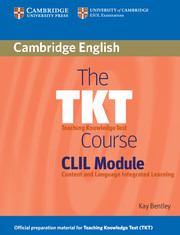Unit 10 - Activity types
Published online by Cambridge University Press: 27 September 2023
Summary
Which activity types are most suitable for CLIL?
Many CLIL activities are similar to those in ELT coursebooks and subject textbooks. These include activities such as those in TKT: categorisation, cloze test, gap fill, labelling, matching, multiple choice, true/false, ordering words/sentences/paragraphs, jigsaw reading and listening. There are also activities such as classification tasks, word/ sentence/text/table completion, information transfer, feature identification, (e.g. underlining key nouns), freeze frames, pyramid discussion, poster presentations and loop or domino games, which are common in CLIL. In CLIL we need to provide activities
for communicating subject content orally
for developing listening and reading strategies
for supporting written or physical production.
Activities need to be linked and sequenced so they are progressively challenging. Learners are more likely to be motivated if the activities are meaningful and relevant and if they know the purpose of the activity. Learners need to know the differences between spoken and written forms of language used during activities.
Key concepts
Are there any activities which are suitable for particular curricular subjects? Some activities, such as matching, carrying out surveys and web searches, are used in most CLIL subjects but some activities are used more often in some subjects than in others.
Here are examples of activities used in curricular subjects. Which can be used in other subjects?
We need to know the purpose and focus of activities so that learners can develop subject-specific skills as well as lower order and higher order thinking skills.
Look at the two sets of activities which follow the presentation of topics from history. The first is from an ELT coursebook with CLIL sections and the second is from the Workbook of a CLIL history course.
Here are interactive activities from a native-speaker website. We can also adapt these for CLIL.
Look at the possibilities for adapting them during the lesson.
In the CLIL section of the ELT coursebook, the purpose of the activities is to develop writing skills from a model text and then to extend writing with a creative followup. In the CLIL Workbook, the purpose of the activities is to produce historical facts accurately and then to progress to higher order thinking skills needed for studying
history.
- Type
- Chapter
- Information
- The TKT Course CLIL Module , pp. 57 - 63Publisher: Cambridge University PressPrint publication year: 2010



